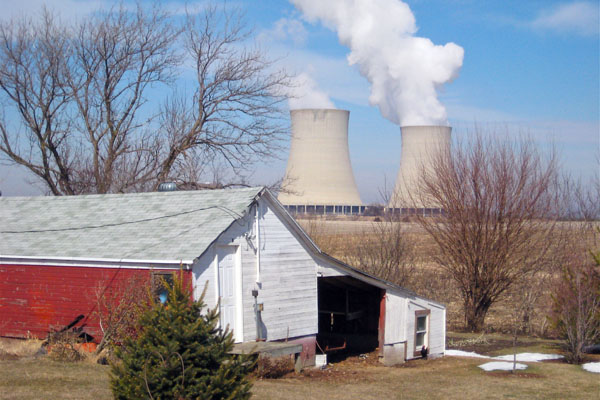The Exelon nuclear power plant in Byron, Ill. paid $1.2 million to settle complaints about tritium leaks here and at two other sites. Exelon is the country’s largest nuclear plant operator, with six facilities. (Photo: Robert Ray / AP)
Tritium is one of those elements that just sounds bad. There’s something about the name that simply feels radioactive even before you know what the stuff is. That’s one of the reasons people have been so spooked by a new investigation the Associated Press conducted of Nuclear Regulatory Commission records, revealing that tritium has leaked from power plants at a disturbing 48 of 65 sites studied. According to the AP story:
Radioactive tritium has leaked from three-quarters of U.S. commercial nuclear power sites, often into groundwater from corroded, buried piping. The number and severity of the leaks has been escalating, even as federal regulators extend the licenses of more and more reactors across the nation. Leaks from at least 37 … facilities contained concentrations exceeding the federal drinking water standard — sometimes at hundreds of times the limit.
So, be afraid, be very afraid, right? Well, maybe — but maintain some perspective too.
Tritium is a radioactive form of hydrogen with a half-life of 12.3 years. There’s a little bit of it everywhere, a background level that has nothing to do with human activity. That level rose significantly during the 1950s and 1960s, when the U.S. and other countries freely tested nuclear weapons above ground. The concentration has come back down with the enforcement of various test ban treaties, though emissions from weapons manfacturers and nuclear power plants do still keep it artificially elevated.
No amount of tritium is entirely safe, since any radioactive element can raise the risk of cancer — even if only slightly. But tritium is not considered one of the most dangerous of those elements, and indeed, is on the lower end of the risk spectrum. According to the EPA:
Tritium primarily enters the body when people swallow tritiated water. People may also inhale tritium as a gas in the air, and absorb it through their skin. [B]ecause it emits very low energy radiation and leaves the body relatively quickly, for a given amount of activity ingested, tritium is one of the least dangerous radionucleides.
That’s the sort of good news; the worse news is that since water is the typical vehicle for tritium ingestion, the element disperses easily throughout the body and can settle in all soft tissues. It takes about a month before it’s excreted via the urinary system, though tritium that becomes chemically bound to tissues will stay put.
The AP study focused principally on tritium leaking from plants via corroded piping or other flaws in safety systems and settling, disturbingly, into the water table. At one plant in new Jersey, tritium leaked into an aquifer and from there into Barnegat Bay off the Atlantic Ocean. Throughout the AP’s lengthy exposé, there are numbers to turn your hair white: The Vermont Yankee reactor, which has leaked tritium at a level 125 times what the EPA considers safe for drinking water; the Browns Ferry reactor in Alabama where the limit was exceeded 100-fold during a spill in 2010; the Quad Cities plant in Illinois that topped out at a shocking 375 times the limit during one leak in 2008.
There’s no putting a good face on that, but hysteria is not wise either. For one thing, the EPA puts the safe limit for tritium exposure at 20,000 picocuries per liter of drinking water. A picocurie is one trillionth of a curie—which is itself a measure of nuclear decay, a concept that is not entirely illuminating when all you want to know is whether your tap water is safe. Suffice to say that even 20,000 picocuries in a liter of water is hardly certain death: If 200,000 people drank contaminated water over the course of decades, only seven of them would develop cancer as a result. That’s hardly reassuring if you’re one of the seven — but the odds are undeniably greater that you’ll be one of the other 199,993.
None of this means that the leaking tritium poses no risk at all, especially with the advancing age of many U.S. nuke plants — some of which have been on the job for 40 years. But it does mean we shouldn’t ignore the elephant in the living room either. Worrying too much about the small risk of tritium-triggered cancer from nuclear reactors while ignoring the far more immediate danger posed by coal-fired plants, which pour massive amounts of sulfur dioxide, particulates, mercury and CO2 into the air everyday is a little like sweating the mad cow pathogen that could be in your burger and thinking nothing of the cholesterol that’s definitely there.
Nearly all conventional methods of producing energy are dirty and — potentially — deadly. Only a true conversion to clean renewables will change that hard fact of environmental life.


